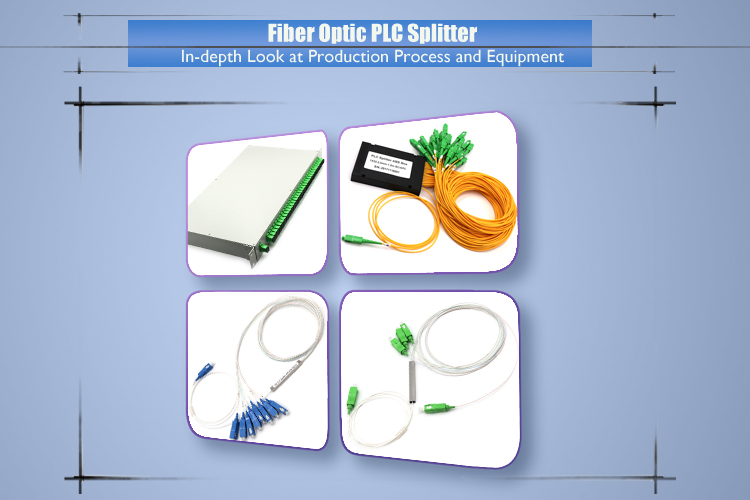By goodvin | 18 January 2024 | 0 Comments
An In-depth Look at Production Process and Equipment of Fiber Optic PLC Splitter
An In-depth Look at Production Process and Equipment of
Fiber Optic PLC Splitter
Fiber Optic PLC Splitter
Introduction
Optical fiber technology has revolutionized modern communication systems, enabling rapid and efficient data transmission over long distances worldwide. One essential component of these systems is the fiber optic PLC splitter, which serves as an effective means of managing and distributing optical signals. This blog provides a comprehensive introduction to the production process and equipment involved in manufacturing high-quality fiber optic PLC splitters. By understanding these key aspects, professionals within the field can better appreciate their vital role in the deployment of advanced communication systems.

Overview of Fiber Optic PLC Splitter
A fiber optic PLC splitter, or Planar Lightwave Circuit splitter, is a passive optical device that evenly divides a single optical signal into multiple outputs. This function is particularly important in telecommunication networks, including Fiber to the Home (FTTH) and Passive Optical Networks (PON), as it allows simultaneous service for multiple end-users. Placing a considerable emphasis on performance, reliability, and scalability, fiber optic PLC splitters are designed to accommodate the ever-growing demands of modern networking infrastructure.
Production Process of Fiber Optic PLC Splitter
The manufacturing process of fiber optic PLC splitters can be broadly divided into the following stages:
1. Planar Lightwave Circuit Fabrication: This step involves wafer production, where silica glass is processed using techniques like photolithography and etching. The final product is a chip that contains the essential waveguide structure and splitter function.
2. Fiber Array Alignment and Attachment: To ensure excellent optical performance, pre-terminated optical fibers are accurately aligned and connected to the input and output ports of the splitter chip. This is achieved using advanced alignment tools and precision manufacturing processes.
3. Package Assembly and Sealing: The combined chip and fiber array assembly are then encapsulated within a stable, protective housing. This packaging is crucial for physically safeguarding the delicate components from damage and environmental conditions, as well as for providing secure installation points within the network infrastructure.
4. Testing and Quality Control: Finally, each fiber optic PLC splitter undergoes rigorous testing and inspection to guarantee optimal performance and longevity. This includes optical performance measurement, environmental testing, and final product inspection to ensure conformance with industry standards.
Equipment Used in Fiber Optic PLC Splitter Production
The production of fiber optic PLC splitters requires specialized equipment to achieve the desired level of precision, accuracy, and reliability. Some key equipment and tools involved in the production process include:
1. Photolithography Equipment: During the wafer fabrication stage, photolithography equipment is used to transfer intricate patterns onto the silica glass with high precision, thereby setting the foundation for the lightwave circuit design.
2. Fiber Array Bonding Equipment: To ensure precise alignment and attachment of fibers to the splitter chip, advanced bonding and assembly systems are utilized. These tools provide a stable and controlled environment for accurate fiber placement and subsequent bonding procedures.
3. Package Sealing Equipment: Sealing of the chip and fiber array assembly within the protective housing is achieved using specialist package sealing equipment. This ensures that the finished product is secure and resistant to external influences, such as moisture and temperature variations.
4. Testing and Measurement Equipment: This encompasses a range of optical and environmental testing equipment that evaluates the functionality and reliability of the fiber optic PLC splitter throughout various stages of the manufacturing process.
Conclusion
The production process and equipment involved in manufacturing fiber optic PLC splitters play a crucial role in the functionality and effectiveness of these vital components in modern communication systems. Understanding these aspects from a professional perspective ensures that quality and performance expectations are met, ultimately contributing to the success and advancement of global telecommunication networks.
Keywords: fiber optic PLC splitter, production process, optical performance, Planar Lightwave Circuit, communication systems
Leave a Reply
Your email address will not be published.Required fields are marked. *
POPULAR BLOG
- Guide to the Construction of Optical Fiber Cable Factories
- The Future of Fiber Optic Access Networks: An Expert Perspective
- Market Analysis of Fiber Optic Testing Equipment: Key Trends and Insights
- Will SDM Technology Become the Only Way for High-Capacity Optical Transmission?
- Fiber Optic Network Development Strategy and Technical Roadmap